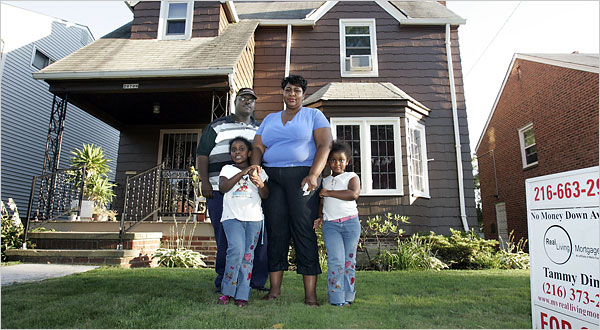Predatory Lending in African American Communities
 The signs are not positive that the bailout passed by Congress will work.
The signs are not positive that the bailout passed by Congress will work.
by Stack Kenny
On October 1 the Washington Bureau of the NAACP issued an Urgent Action Alert asking Congress to address the immediate, dire problem of home foreclosures, especially in the African American communities hit hardest by unjust predatory lending practices. By the end of the week, Congress had ignored the plea of the NAACP and other advocate groups, and passed legislation without any intention of helping people stay in their homes.
An estimated six-and-a-half million foreclosures are expected as a result of this economic disaster. Already 10,000 people a week are losing their homes. Couple this with three-quarters of a million jobs lost in the past nine months, including 159,000 in September alone, and the picture ahead is bleak.
The current economic crisis has been fueled by the massive number of
mortgage defaults instigated by banks and brokers to purposefully fail.
There was so much money to be made in the fees and services of these
loans, and the subsequent reselling and packaging of the inflated
mortgages, that it was too easy for investors to overlook the
inevitable collapse of the economics behind them. The immediate profit
was so great that soon even people with inadequate means were urged to
take on mortgages.
The African American and Latino communities were targeted explicitly
for this scam in what has become known as predatory lending practices,
or subprime mortgage fraud. In this scenario, a mortgage broker offers
a new home or refinancing of an existing loan without a down payment.
After a year or two of manageable monthly payments, the buyer gets hit
with an unaffordable, skyrocketing increase in the interest rate. The
possible increases are often described only in the fine print. (Some of
these Adjustable Rate Mortgages [ARMs] went from 2.0% or 2.5% to as
much as 11.0% over as little as a year-and-a-half.) As jobs fail and
wages remain stagnant, the homeowner is forced to give up his house.
Change from the Past
Fannie Mae, founded in 1938, and Freddie Mac, founded in 1970, were
so-called “Government Sponsored Enterprises” (GSEs) established to buy
mortgages from banks that issued them, so that the banks could use that
money to make ever more home loans. The GSEs were, in effect, letting
the banks off the hook for the loans they made, but in exchange they
required strict rules for the banks to follow in making the mortgages
in the first place. The GSEs then packaged the mortgages they bought as
securities and sold them to other investors, in effect guaranteeing the
investments with implied US government backing.
But most people of color had been excluded from the ten million new
homeowners whose homes were financed by the FHA and Fannie Mae in the
decades after World War II. By 1965, only 2% of all new home mortgages
had been issued to people of color, and little changed after the
establishment of Freddie Mac in 1970.
In 1977, Jimmy Carter tried to change this with the Community
Reinvestment Act, which outlawed redlining, or denying loans, in poor
(read black) neighborhoods. At first the banks fought this law, but
slowly and grudgingly began to extend mortgage lending to people of
color, following the same strict regulations as were required for other
mortgages. Over the next decade – the Cosby Show years – homeownership
for minorities grew steadily.
But the Reagan administration began an era of deregulating that
continued through the Bush I and Clinton presidencies, speeding up with
the Republican takeover of Congress in 1994 and culminating in complete
repeal of Depression-era regulatory rules in 1999. That year Sen. Phil
Gramm spearheaded the Gramm-Leach-Bliley law that gave full license to
investment banks and brokerages to move in on the territory of
commercial banks (those that made home loans), and removed all
meaningful regulation of them all.
The investment community embraced the Gramm bill, and the subprime
mortgage industry was born. Under Reagan deregulation had blossomed,
but it exploded in 2004 with George Bush’s policy of a “Home Ownership
Society.” Soon, 50 percent of all mortgages were in the subprime
market, and African Americans owned a significant portion of those
loans.
Since then, the number of foreclosures has been on a steady rise,
leading to today’s market implosion. Most of the values of these houses
were intentionally inflated beyond their actual worth and many people
refinanced homes based on the inflated figures. As the market tumbled
and houses returned to their original value, homeowners still had to
pay the interest on the over-inflated loan. Foreclosures followed from
there.
United for Fair Economy, a watchdog advocacy group, claims there has
been a $213 billion wealth loss for people of color due to the subprime
fiasco. Although current statistics were unavailable for Asheville and
Buncombe County at the time of this writing, Celeste Collins of
“OnTrack,” a financial education and counseling service, said they were
already starting to see the local effects of the mortgage crisis.
A typical picture of predatory lending may be observed in Fulton
County, Georgia, outside Atlanta, where in one month last year, 18,000
people of color lost their homes. Following Bush’s 2004 “Home Ownership
Society” policy, three-fourths of Fulton County’s foreclosures were on
loans made since 2005, half of them on loans from 2006.
This was a program intentionally made to fail, and a lot of money was made in the process.








